移动通信技术发展及展望
移动通信的未来展望
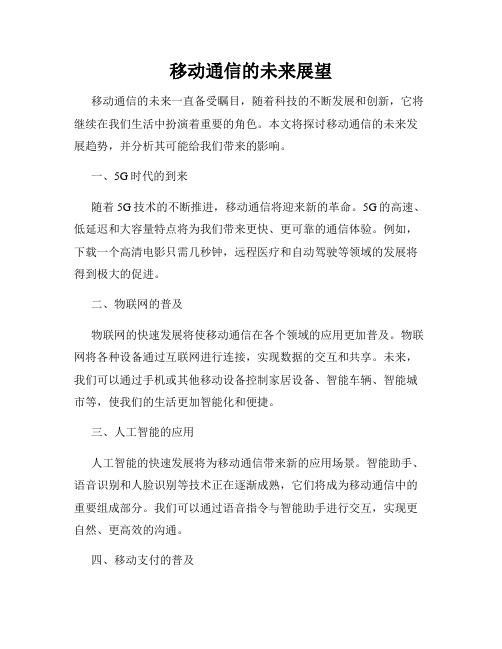
移动通信的未来展望移动通信的未来一直备受瞩目,随着科技的不断发展和创新,它将继续在我们生活中扮演着重要的角色。
本文将探讨移动通信的未来发展趋势,并分析其可能给我们带来的影响。
一、5G时代的到来随着5G技术的不断推进,移动通信将迎来新的革命。
5G的高速、低延迟和大容量特点将为我们带来更快、更可靠的通信体验。
例如,下载一个高清电影只需几秒钟,远程医疗和自动驾驶等领域的发展将得到极大的促进。
二、物联网的普及物联网的快速发展将使移动通信在各个领域的应用更加普及。
物联网将各种设备通过互联网进行连接,实现数据的交互和共享。
未来,我们可以通过手机或其他移动设备控制家居设备、智能车辆、智能城市等,使我们的生活更加智能化和便捷。
三、人工智能的应用人工智能的快速发展将为移动通信带来新的应用场景。
智能助手、语音识别和人脸识别等技术正在逐渐成熟,它们将成为移动通信中的重要组成部分。
我们可以通过语音指令与智能助手进行交互,实现更自然、更高效的沟通。
四、移动支付的普及移动支付正变得越来越普及和便捷,未来将在更多领域得到应用。
通过移动通信,我们可以使用手机进行支付,无需携带现金或信用卡。
这将为我们的生活带来更多便利,同时也将对传统支付方式产生深远影响。
五、安全和隐私问题随着移动通信技术的不断发展,安全和隐私问题也备受关注。
未来,我们需要更多的安全措施来保护我们的通信和个人信息。
同时,相关的法律法规也需要跟进,确保移动通信的安全和合法使用。
六、可持续发展移动通信的未来展望还包括可持续发展方面的考虑。
新技术和新设备的推出将不可避免地带来环境压力。
因此,研究和开发环保型的移动通信设备和技术将成为未来的重要课题。
总结:移动通信的未来展望充满着无限的可能性。
通过5G技术的发展、物联网的普及、人工智能的应用、移动支付的普及以及安全和隐私问题的关注,我们可以看到一个更加智能、便捷、安全和可持续的移动通信世界的未来。
我们期待着这个未来的到来,它必将深刻地改变我们的生活方式和社会发展。
2024年我国移动通信发展论文

2024年我国移动通信发展论文一、引言自20世纪80年代起,移动通信技术在我国经历了飞速的发展和变革。
从最初的模拟信号,到后来的数字信号,再到如今的4G、5G网络,每一步的跨越都标志着我国在移动通信领域的巨大进步。
移动通信技术的快速发展,不仅改变了人们的日常生活方式,也为国家的经济发展和社会进步提供了强大的技术支持。
二、移动通信技术的演进(一)模拟移动通信时代我国的移动通信起源于20世纪80年代,最初的移动通信系统采用模拟信号传输方式,主要以大哥大为代表。
虽然此时的通信质量并不稳定,覆盖范围也有限,但它标志着移动通信技术在我国的初步应用。
(二)数字移动通信时代随着技术的不断进步,90年代初,我国开始进入数字移动通信时代。
这一时期的代表技术是GSM(全球移动通信系统)。
数字通信的引入,大大提高了通信质量和信号的稳定性,同时也扩大了覆盖范围。
(三)3G移动通信时代进入21世纪后,我国的移动通信技术迎来了3G时代。
3G技术相较于2G,具有更高的数据传输速率和更好的网络性能,使得移动互联网的应用更加广泛。
此时,智能手机开始普及,各种基于移动互联网的应用如雨后春笋般涌现。
(四)4G与5G移动通信时代近年来,随着4G技术的广泛应用,我国的移动通信进入了全新的发展阶段。
4G技术提供了更快的网络速度和更低的延迟,进一步推动了移动互联网的普及和应用。
而5G技术的出现,更是为我国的移动通信带来了新的飞跃。
5G网络具有超高的数据传输速率、极低的延迟和广泛的连接能力,将为实现万物互联、智能化社会提供强大的技术支持。
三、我国移动通信发展的影响因素(一)政策推动政府在移动通信发展中起到了关键的作用。
我国政府通过制定相关的政策和规划,为移动通信的发展提供了有力的支持。
例如,在频谱分配、基础设施建设、技术研发等方面,政府都给予了大力的支持和推动。
(二)市场需求随着经济的发展和人民生活水平的提高,人们对通信服务的需求也不断增加。
5G技术的发展现状和未来趋势展望
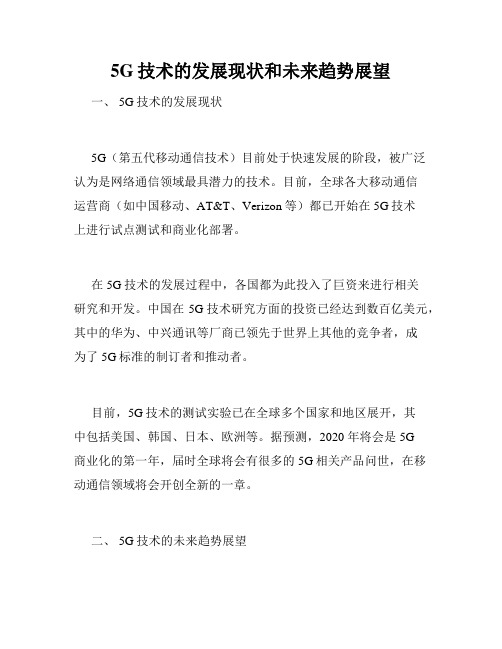
5G技术的发展现状和未来趋势展望一、 5G技术的发展现状5G(第五代移动通信技术)目前处于快速发展的阶段,被广泛认为是网络通信领域最具潜力的技术。
目前,全球各大移动通信运营商(如中国移动、AT&T、Verizon等)都已开始在5G技术上进行试点测试和商业化部署。
在5G技术的发展过程中,各国都为此投入了巨资来进行相关研究和开发。
中国在5G技术研究方面的投资已经达到数百亿美元,其中的华为、中兴通讯等厂商已领先于世界上其他的竞争者,成为了5G标准的制订者和推动者。
目前,5G技术的测试实验已在全球多个国家和地区展开,其中包括美国、韩国、日本、欧洲等。
据预测,2020 年将会是5G商业化的第一年,届时全球将会有很多的5G相关产品问世,在移动通信领域将会开创全新的一章。
二、 5G技术的未来趋势展望1. 5G商用化的加快预计,2020年将是5G商用化的第一年,届时5G技术将进一步成熟,更多的厂商将会投入到5G领域的研究和开发中来。
通过5G技术的发展,我们可以预期移动通信领域将会向“物联网+”、“人工智能+”等新兴领域延伸,推动各类智能设备和应用的发展和推广。
2. 5G产品技术升级随着5G技术的不断成熟,各类5G相关产品将不断推陈出新,并不断优化升级。
比如,在手机领域,5G手机将成为市场主流,而且与此紧密相关的各种智能设备也将随之进入市场,包括可穿戴设备、智能家居产品等等。
3. 5G技术应用范围的扩大有了5G技术的支持,将会有更多场景与应用得到推行和发展。
比如,无人车、智能农业、智能物流等领域,都将在5G的支持下得到进一步的普及和发展。
未来将会有越来越多的企业和行业将5G技术应用于其业务之中。
4. 5G技术标准的不断完善随着5G技术发展的不断深入,各国的研发力量将逐渐提升,5G技术标准也将不断完善。
国际标准组织也将与各国的相关企业和组织密切合作,推动5G技术的全面发展。
5. 5G技术的全球推广随着5G技术商用的逐渐普及,将会有越来越多的国家和地区开始推广5G技术。
移动通信的发展趋势

移动通信的发展趋势随着科技的不断进步和人们对通信方式的需求不断增加,移动通信技术也在不断发展。
移动通信已经成为当今社会中最重要的基础设施之一,为人们的生活和工作带来了巨大的便利。
本文将讨论移动通信的发展趋势,并对未来的发展进行展望。
1. 5G技术的普及与应用随着第五代移动通信技术(5G)的到来,移动通信将迎来一场革命性的变革。
5G技术将带来更高的网速、更低的延迟和更大的容量,这将大大提升移动通信的性能和用户体验。
未来,更多的人将能够享受到高速的移动网络,不仅能够更方便地上网冲浪,还能够支持更多的智能设备和应用,比如自动驾驶汽车、智能家居和虚拟现实等。
2. 物联网的兴起物联网是指通过互联网将各种日常用品和设备连接起来,实现智能化管理和互联互通。
移动通信技术的发展为物联网的兴起提供了基础支撑。
未来,越来越多的设备将具备连接互联网的能力,形成一个庞大的网络。
人们可以通过手机或其他设备控制家庭电器、汽车、办公设备等,实现智能化的生活和工作。
物联网的兴起将深刻改变人们的生活方式和工作方式,为各行各业带来更多的机遇和挑战。
3. 虚拟现实技术的发展虚拟现实技术是指利用计算机生成的虚拟环境来模拟真实场景,并通过特殊设备使用户能够身临其境地感受其中的内容和体验。
移动通信技术的进步为虚拟现实技术的发展提供了强有力的支持。
通过5G网络的高速和低延迟特性,用户可以更流畅地体验虚拟现实内容,从而实现更丰富的娱乐和更高效的工作。
未来,虚拟现实技术有望在教育、医疗、游戏等领域得到广泛应用,为人们创造更多的惊喜和价值。
4. 安全与隐私保护的挑战随着移动通信技术的发展,安全和隐私保护也成为了重要的问题。
人们越来越依赖移动通信进行各种敏感信息的传输,如个人隐私、支付信息等。
然而,网络安全威胁也不断增加,比如黑客攻击和数据泄露等。
因此,未来的移动通信技术需要更加关注用户数据的保护和隐私的呵护,加强安全措施,确保用户的信息和权益不受侵犯。
通信技术行业发展趋势与未来展望
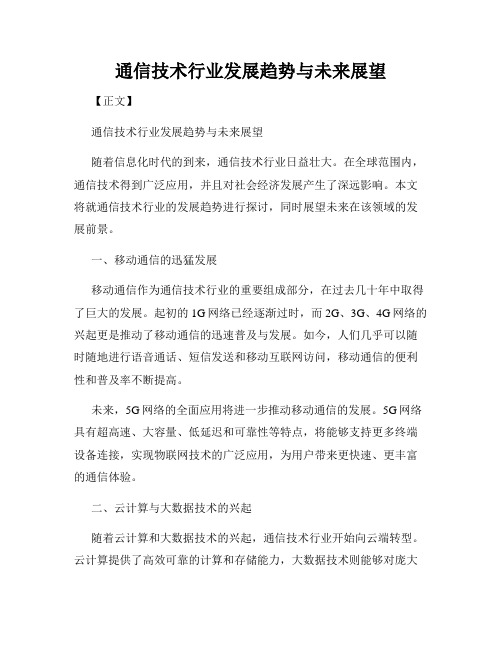
通信技术行业发展趋势与未来展望【正文】通信技术行业发展趋势与未来展望随着信息化时代的到来,通信技术行业日益壮大。
在全球范围内,通信技术得到广泛应用,并且对社会经济发展产生了深远影响。
本文将就通信技术行业的发展趋势进行探讨,同时展望未来在该领域的发展前景。
一、移动通信的迅猛发展移动通信作为通信技术行业的重要组成部分,在过去几十年中取得了巨大的发展。
起初的1G网络已经逐渐过时,而2G、3G、4G网络的兴起更是推动了移动通信的迅速普及与发展。
如今,人们几乎可以随时随地进行语音通话、短信发送和移动互联网访问,移动通信的便利性和普及率不断提高。
未来,5G网络的全面应用将进一步推动移动通信的发展。
5G网络具有超高速、大容量、低延迟和可靠性等特点,将能够支持更多终端设备连接,实现物联网技术的广泛应用,为用户带来更快速、更丰富的通信体验。
二、云计算与大数据技术的兴起随着云计算和大数据技术的兴起,通信技术行业开始向云端转型。
云计算提供了高效可靠的计算和存储能力,大数据技术则能够对庞大的数据进行高效分析和挖掘。
这两种技术的结合为通信技术行业带来了新的发展机遇。
云计算和大数据技术的发展不仅提高了通信技术行业的效率和可靠性,还为用户提供了更加智能化的服务。
例如,通过大数据分析用户行为,可以为用户提供个性化的推荐服务;而云存储技术则让用户可以随时随地访问自己的数据。
未来,随着云计算和大数据技术的不断突破和完善,通信技术行业将进一步加强与其他行业的融合,推动数字经济的发展。
三、物联网与智能家居的崛起物联网是指通过互联网连接各种物理设备,实现设备之间的信息交互和智能化控制。
随着各种智能设备的普及,物联网的概念被广泛提出,也为通信技术行业带来了新的发展机遇。
未来,随着物联网技术的不断成熟,智能家居将成为通信技术行业的一大发展方向。
通过智能家居系统,人们可以实现对家居设备的远程监控和控制,实现家居自动化管理。
例如,通过智能音箱可以语音控制家中的电器设备,通过智能摄像头可以实时观看家中的情况。
移动通信技术的现状与发展
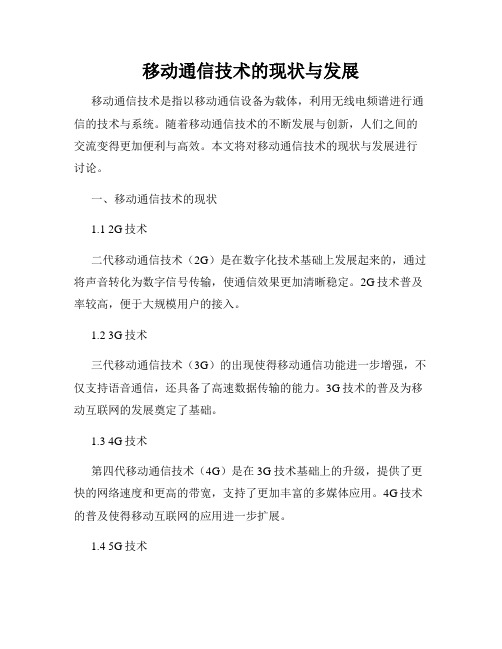
移动通信技术的现状与发展移动通信技术是指以移动通信设备为载体,利用无线电频谱进行通信的技术与系统。
随着移动通信技术的不断发展与创新,人们之间的交流变得更加便利与高效。
本文将对移动通信技术的现状与发展进行讨论。
一、移动通信技术的现状1.1 2G技术二代移动通信技术(2G)是在数字化技术基础上发展起来的,通过将声音转化为数字信号传输,使通信效果更加清晰稳定。
2G技术普及率较高,便于大规模用户的接入。
1.2 3G技术三代移动通信技术(3G)的出现使得移动通信功能进一步增强,不仅支持语音通信,还具备了高速数据传输的能力。
3G技术的普及为移动互联网的发展奠定了基础。
1.3 4G技术第四代移动通信技术(4G)是在3G技术基础上的升级,提供了更快的网络速度和更高的带宽,支持了更加丰富的多媒体应用。
4G技术的普及使得移动互联网的应用进一步扩展。
1.4 5G技术目前,5G技术正处于快速发展阶段,被视为移动通信技术的下一代标准。
5G技术将提供更大的带宽、更低的延迟和更稳定的连接,为人们的生活带来了更多的便利与可能。
二、移动通信技术的发展趋势2.1 多频段技术随着移动通信用户的不断增加,对频谱资源的需求也相应增加。
多频段技术可以充分利用不同频段的资源,提高网络容量和用户体验。
2.2 蜂窝网络扩展蜂窝网络是移动通信的基础,随着用户数量的增加和数据传输量的增大,对蜂窝网络的扩展和优化将成为未来发展的重点。
2.3 物联网与边缘计算物联网的兴起使得各类设备能够互相连接,边缘计算的引入可以减少数据传输的延迟,提高系统的响应速度,物联网与边缘计算将为移动通信技术的发展带来新的机遇与挑战。
2.4 人工智能的应用人工智能技术的飞速发展为移动通信技术的应用提供了更多可能性。
通过人工智能算法的优化,可以提高网络的智能化水平,提供更好的用户体验。
三、移动通信技术的应用领域拓展3.1 移动支付移动支付已经成为人们日常生活中不可或缺的一部分。
移动通信发展的现状及未来趋势探讨

移动通信发展的现状及趋势探讨移动通信发展的现状及趋势探讨引言随着技术的不断进步,移动通信已成为现代社会中不可或缺的一部分。
本文将探讨移动通信的当前状态,并对的发展趋势进行展望。
1. 移动通信的现状移动通信已经取得了巨大的发展,并在各个方面产生了深远的影响。
以下是移动通信现状的几个关键点:1.1 移动用户数量的增长随着智能方式的普及,移动用户数量呈现出持续增长的趋势。
据统计,全球移动用户数量已经超过50亿,并且仍在不断增长。
1.2 移动网络技术的演进移动通信网络技术不断演进,从2G、3G到4G,再到如今的5G 网络,每一代移动网络技术的推出都带来了更快的速度和更稳定的连接。
1.3 移动应用的繁荣移动应用的繁荣也是当前移动通信的重要表现之一。
无论是社交媒体、电子商务还是在线支付,移动应用已经渗透到人们生活的方方面面。
2. 移动通信的趋势移动通信的发展将受到技术和市场等多个因素的影响。
以下是我们对移动通信发展的几个趋势的探讨:2.1 5G网络的普及随着5G网络的商用化,移动通信将迎来一个全新的时代。
5G 网络不仅带来了高速的数据传输能力,还将支持更多的终端设备和更复杂的应用场景,如物联网和自动驾驶等。
2.2 网络安全的挑战与应对随着移动通信的不断发展,网络安全问题也变得越来越重要。
网络安全将成为一个巨大的挑战,移动通信相关企业需要加强网络安全防护,保护用户的隐私和数据安全。
2.3 移动通信与云计算的融合移动通信和云计算将会越来越密切地结合在一起。
移动终端将成为云计算的重要组成部分,用户可以通过移动设备随时随地访问云端的数据和服务。
2.4 的应用技术的不断进步将为移动通信带来新的机遇。
可以帮助移动通信系统更加智能化和自动化,提供更好的用户体验和个性化的服务。
2.5 移动通信与物联网的融合移动通信和物联网的融合将会给人们的生活带来巨大的改变。
通过移动通信技术,各种设备和物品可以互相连接,实现智能化和自动化的功能。
移动通信技术的发展现状与未来展望
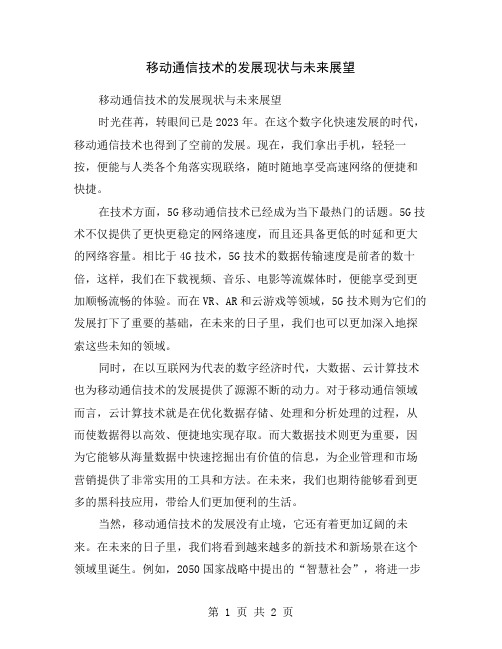
移动通信技术的发展现状与未来展望移动通信技术的发展现状与未来展望时光荏苒,转眼间已是2023年。
在这个数字化快速发展的时代,移动通信技术也得到了空前的发展。
现在,我们拿出手机,轻轻一按,便能与人类各个角落实现联络,随时随地享受高速网络的便捷和快捷。
在技术方面,5G移动通信技术已经成为当下最热门的话题。
5G技术不仅提供了更快更稳定的网络速度,而且还具备更低的时延和更大的网络容量。
相比于4G技术,5G技术的数据传输速度是前者的数十倍,这样,我们在下载视频、音乐、电影等流媒体时,便能享受到更加顺畅流畅的体验。
而在VR、AR和云游戏等领域,5G技术则为它们的发展打下了重要的基础,在未来的日子里,我们也可以更加深入地探索这些未知的领域。
同时,在以互联网为代表的数字经济时代,大数据、云计算技术也为移动通信技术的发展提供了源源不断的动力。
对于移动通信领域而言,云计算技术就是在优化数据存储、处理和分析处理的过程,从而使数据得以高效、便捷地实现存取。
而大数据技术则更为重要,因为它能够从海量数据中快速挖掘出有价值的信息,为企业管理和市场营销提供了非常实用的工具和方法。
在未来,我们也期待能够看到更多的黑科技应用,带给人们更加便利的生活。
当然,移动通信技术的发展没有止境,它还有着更加辽阔的未来。
在未来的日子里,我们将看到越来越多的新技术和新场景在这个领域里诞生。
例如,2050国家战略中提出的“智慧社会”,将进一步推动物联网、车联网、人工智能等新技术的发展,在实现人们生活和工作的数字化、智能化的同时,也将带来移动通信技术的新一轮高速发展。
有人预测,到了未来,我们甚至可以通过移动网络来远程操作、完成家庭和办公室的日常事务。
如此看来,移动通信技术作为数字化经济的基础性产业,已经与人们的生活和工作紧密相连。
未来,只要我们牢牢把握先进技术的发展,在以5G为代表的新一轮技术改革中积极参与,我们便可以享受到这个领域带给我们各种各样的好处和益处。
移动通信技术的发展与趋势

移动通信技术的发展与趋势随着科技的不断进步和人们生活方式的改变,移动通信技术在过去几十年间发展迅猛。
从最初的1G模式到现在的5G网络,移动通信技术已经成为现代社会不可或缺的一部分。
本文将探讨移动通信技术的发展历程,并展望未来的趋势。
一、移动通信技术的初期发展移动通信技术的起源可以追溯到上世纪80年代,当时推出的1G模式实现了模拟语音通信的功能。
这一技术的问世极大地改变了人们的通信方式,使得人们可以在没有固定电话线路的情况下进行电话交流。
然而,1G技术存在着信号质量差、通话不稳定等问题,无法满足日益增长的通信需求。
二、移动通信技术的进一步发展为了克服1G技术存在的问题,人们开始研究和开发2G技术。
2G技术的问世将数字通信引入了移动通信领域,大大提高了通信质量和稳定性。
2G技术还引入了短信功能,进一步丰富了人们的通信方式。
然而,随着移动通信用户数量的不断增加,2G技术的容量和速率已经无法满足需求。
随后,在2001年,3G技术问世。
3G技术实现了移动宽带接入,使得人们可以在手机上浏览互联网、观看视频等。
3G技术的出现标志着移动通信技术进入了一个全新的阶段,使得人们的生活更加便捷。
然而,3G技术的速率对于高质量视频、在线游戏等应用仍然存在一些限制。
三、移动通信技术的现状与趋势随着移动互联网的兴起和人们对高速和高质量通信的需求增加,4G技术应运而生。
4G技术的数据传输速率更快,延迟更低,为人们提供了更好的使用体验。
除了高速数据传输,4G技术还支持高清视频通话、移动支付等功能,深度融入人们的日常生活。
目前,5G技术已经开始商用。
5G技术将提供更快的速率、更低的延迟和更稳定的连接,将为人们带来更加无缝的通信体验。
除了更好的用户体验,5G技术还将支持更多物联网设备的连接,推动智能家居、智能工厂等领域的发展。
未来,5G技术有望在无人驾驶、远程医疗等领域发挥重要作用。
尽管5G技术已经取得了重大突破,但移动通信技术的发展并未止步于此。
未来移动通信的展望

未来移动通信的展望随着科技的不断发展,移动通信技术正以迅猛的速度改变着人们的生活。
随着5G技术的逐渐成熟和广泛应用,未来移动通信的展望变得更加引人瞩目。
本文将探讨未来移动通信的发展趋势以及其中所蕴含的机遇和挑战。
一、5G技术将引领未来发展5G技术作为未来移动通信的核心,将带来以前所未有的高速、低延迟和大容量传输体验。
它不仅能够支持更多终端设备的连接,还能满足应用于虚拟现实、智能交通、智慧城市等领域的需求。
未来,我们将能够享受到更快的下载速度,更流畅的视频通话和在线游戏体验。
二、智能物联网将催生新兴市场随着5G技术的普及,智能物联网将迎来爆发式的增长。
物联网的概念指的是通过互联网将各种感知设备、传感器和物体连接起来,实现信息的互通和共享。
未来,智能家居、智慧医疗、智能交通等领域将得到极大的发展,提升人们的生活质量和便利性。
这也将带来一个新的市场,创造更多的就业机会和经济增长点。
三、安全和隐私问题需重视随着移动通信技术的不断演进,安全和隐私问题也逐渐凸显出来。
未来移动通信的发展必然伴随着更多的数据传输和互联互通,个人信息可能面临更大的风险。
加强网络安全的建设,制定更完善的法规和技术标准是解决这一问题的关键。
只有保护好用户的隐私,才能确保移动通信技术的健康发展。
四、边缘计算和人工智能融合未来移动通信技术的发展离不开边缘计算和人工智能的融合。
边缘计算将移动计算和云计算相结合,减少延迟,提高响应速度,为用户提供更好的体验。
而人工智能则能够通过大数据分析和深度学习,为移动通信提供更精准、智能的服务。
这两者的融合共同推动着移动通信技术的进一步创新和发展。
五、全球合作促进发展未来移动通信技术的发展需要全球各国的共同努力和合作。
通过合作,可以共享资源和经验,促进技术的创新和优化。
同时,还可以打破地域限制,实现信息的全球流通。
只有通过全球合作,才能推动移动通信技术的快速发展,并让更多人从中受益。
六、结语未来移动通信的展望充满着无限的可能性。
浅析5G移动通信技术及发展趋势
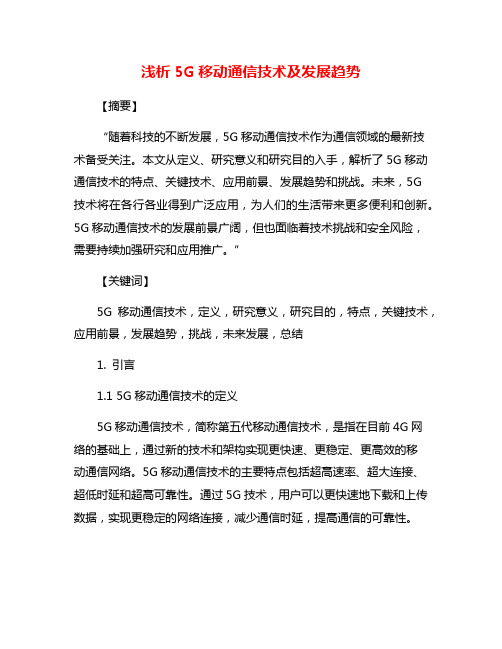
浅析5G移动通信技术及发展趋势【摘要】“随着科技的不断发展,5G移动通信技术作为通信领域的最新技术备受关注。
本文从定义、研究意义和研究目的入手,解析了5G移动通信技术的特点、关键技术、应用前景、发展趋势和挑战。
未来,5G技术将在各行各业得到广泛应用,为人们的生活带来更多便利和创新。
5G移动通信技术的发展前景广阔,但也面临着技术挑战和安全风险,需要持续加强研究和应用推广。
”【关键词】5G移动通信技术,定义,研究意义,研究目的,特点,关键技术,应用前景,发展趋势,挑战,未来发展,总结1. 引言1.1 5G移动通信技术的定义5G移动通信技术,简称第五代移动通信技术,是指在目前4G网络的基础上,通过新的技术和架构实现更快速、更稳定、更高效的移动通信网络。
5G移动通信技术的主要特点包括超高速率、超大连接、超低时延和超高可靠性。
通过5G技术,用户可以更快速地下载和上传数据,实现更稳定的网络连接,减少通信时延,提高通信的可靠性。
5G移动通信技术的定义可以归纳为:一种新一代移动通信技术,以更高速率、更大连接、更低时延和更高可靠性为主要特点,为用户提供更优质的移动通信服务。
5G移动通信技术的定义体现了移动通信技术的不断创新和发展,为用户带来更便捷、更快速的通信体验。
随着各种行业对5G技术的需求增加,5G移动通信技术将在未来得到更广泛的应用和推广,推动整个移动通信行业向更高水平迈进。
1.2 研究意义5G移动通信技术作为下一代移动通信技术,具有极其重要的研究意义。
随着科技的不断发展,5G移动通信技术将为人们提供更加快速、稳定和高效的通信服务,使人们能够轻松享受到高清视频、虚拟现实等各种高带宽应用。
5G移动通信技术将为各行各业带来巨大的变革,加快智能制造、智慧城市、无人驾驶等领域的发展,推动产业升级和创新。
5G移动通信技术还将促进全球经济的发展,为消费者提供更多元化的服务选择,为企业提供更多商机。
深入研究5G移动通信技术的意义重大,能够推动技术的创新与进步,促进社会的发展与进步。
未来移动通信技术的发展趋势与应用前景

未来移动通信技术的发展趋势与应用前景未来移动通信技术的发展趋势与应用前景随着科技的快速发展,移动通信技术也在不断创新与进步。
未来移动通信技术将受到更多的关注和应用,其发展趋势将对我们的生活方式、工作方式和社会发展产生重要影响。
本文将探讨未来移动通信技术的发展趋势,并对其应用前景进行展望。
一、5G技术的崛起5G技术被认为是未来移动通信技术的重要发展方向。
相较于现有的4G技术,5G技术具有更高的传输速率、更低的延迟以及更大的容量,可以支持更多终端设备的连接。
这将为物联网、智能城市、自动驾驶等领域的发展提供更可靠、更高效的通信技术支持。
二、物联网的普及应用未来移动通信技术的发展将推动物联网的普及应用。
物联网是指通过互联网将各种日常用品、设备、传感器等连接起来,实现智能化管理和自动化控制。
随着移动通信技术的进步,物联网的应用场景将越来越广泛,如智能家居、智能医疗、智能交通等。
这些应用将为我们的生活带来更便捷、更智能的体验。
三、边缘计算的发展边缘计算是一种新的计算模式,将计算和存储资源放置在靠近数据源的地方,实现对数据的即时处理和快速响应。
未来移动通信技术的发展将进一步推动边缘计算的发展。
边缘计算的应用可以加速云计算的响应速度,提高数据的处理效率,满足越来越多的实时性要求,为诸如智能工厂、智能交通等领域的应用提供更强大的支持。
四、人工智能的融合应用未来移动通信技术的发展将与人工智能的融合应用越来越密切。
人工智能依赖于大量的数据和强大的计算能力,而移动通信技术提供了传输和处理数据的基础设施。
移动通信技术的进步将为人工智能的发展提供更好的数据传输和计算支持,进一步推动人工智能技术的应用领域,如智能语音助手、智能机器人等。
综上所述,未来移动通信技术的发展趋势将包括5G技术的崛起、物联网的普及应用、边缘计算的发展以及人工智能的融合应用等。
这些技术的发展将推动社会的进步和发展,为我们的生活带来更多便利和智能化的体验。
中国移动未来发展前景
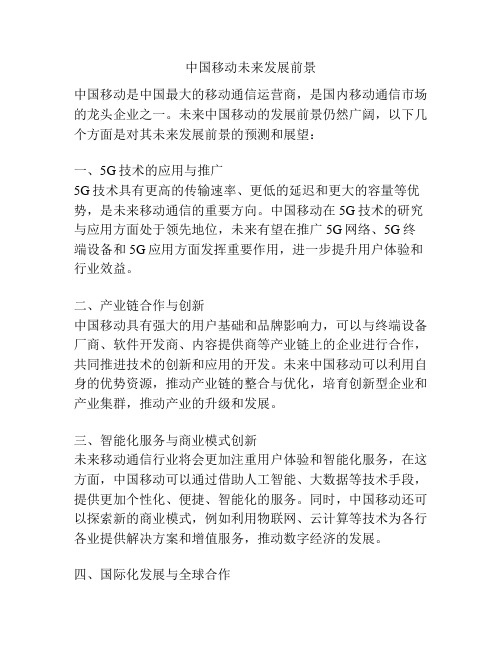
中国移动未来发展前景中国移动是中国最大的移动通信运营商,是国内移动通信市场的龙头企业之一。
未来中国移动的发展前景仍然广阔,以下几个方面是对其未来发展前景的预测和展望:一、5G技术的应用与推广5G技术具有更高的传输速率、更低的延迟和更大的容量等优势,是未来移动通信的重要方向。
中国移动在5G技术的研究与应用方面处于领先地位,未来有望在推广5G网络、5G终端设备和5G应用方面发挥重要作用,进一步提升用户体验和行业效益。
二、产业链合作与创新中国移动具有强大的用户基础和品牌影响力,可以与终端设备厂商、软件开发商、内容提供商等产业链上的企业进行合作,共同推进技术的创新和应用的开发。
未来中国移动可以利用自身的优势资源,推动产业链的整合与优化,培育创新型企业和产业集群,推动产业的升级和发展。
三、智能化服务与商业模式创新未来移动通信行业将会更加注重用户体验和智能化服务,在这方面,中国移动可以通过借助人工智能、大数据等技术手段,提供更加个性化、便捷、智能化的服务。
同时,中国移动还可以探索新的商业模式,例如利用物联网、云计算等技术为各行各业提供解决方案和增值服务,推动数字经济的发展。
四、国际化发展与全球合作中国移动已经在一些国家和地区开展了业务,未来可以加强国际化发展,进一步拓展海外市场。
中国移动与国际移动通信协会、国际电信联盟等国际组织和机构的合作也将对其全球化战略产生重要影响,未来可以积极参与国际标准的制定和推广,为全球移动通信行业的发展做出贡献。
五、可持续发展与社会责任未来中国移动还将更加注重可持续发展和社会责任。
在可持续发展方面,中国移动将继续加大绿色能源使用,提高资源利用率,降低碳排放等方面的努力。
在社会责任方面,中国移动将积极承担社会责任,推动信息化与扶贫、健康、教育、环境保护等领域的深度融合,促进社会的和谐发展。
综上所述,中国移动未来发展前景广阔,将继续在5G技术、产业链合作与创新、智能化服务与商业模式创新、国际化发展与全球合作以及可持续发展与社会责任等多个方面取得新的突破和进展。
新一代移动通信技术研究现状与展望

新一代移动通信技术研究现状与展望随着技术的不断发展,我们的生活越来越离不开手机。
而手机成为必要的通讯工具,却需要一定的通讯技术去支撑。
现今,移动通信技术正处于不断地进化当中,新一代的技术也正在持续研究与发展之中。
本文将探讨新一代移动通信技术的研究现状与未来展望。
1. 什么是新一代移动通信技术?新一代移动通信技术(5G)它是为了满足未来社会对于通信更高需求而开发的,是未来通信的核心技术。
5G不仅仅是对4G的升级,更是一种全新的通信方式,它将能够支持更多的设备,并且在数据传输方面会更加高速,同时还将可以支持更广泛的通信类型,比如说非实时通信、延迟敏感性通信、高可靠性通信等等,这些功能的支持都可以让人们的生活更加便捷和安全。
2. 新一代移动通信技术的研究现状目前,新一代移动通信技术(5G)的研究和发展已经取得了一些进展。
在国际上,3GPP已经在2019年完成了5G第一阶段的标准制定工作,从而引领了5G通信技术的发展。
同时,各个运营商也在积极推动5G的商业化,很多国家都已经开始商用5G网络,并正在逐步建设5G基础设施。
在技术方面,5G的研究与发展不仅限于通信技术本身,同时也包括了与其相关的其他技术领域,比如说物联网、人工智能、云计算、大数据等。
在这些领域,各大企业也正在积极地研究和探索,以期能够更好地支持和应用5G技术。
3. 新一代移动通信技术的未来展望未来,随着新一代移动通信技术(5G)的逐渐普及,人们的生活将会有很大的改变。
5G可以为人类带来更高效、更便捷、更安全、更丰富的通信体验。
举个例子,未来的人们可以通过5G网络实现智能家居控制,智能医疗监测等等。
同时,在工业和农业领域,5G也可以应用于工业自动化和智能农业中,从而提高生产效率和质量,实现产业的升级和转型。
总之,新一代移动通信技术(5G)无疑将带来更多的机遇和挑战。
与此同时,我们也期待可以更好地应用这种技术,为人类带来更好的生活体验。
未来移动通信发展展望

未来移动通信发展展望在当今科技飞速发展的时代,移动通信已经成为人们生活中不可或缺的一部分。
从最初的简单语音通话到如今的高速数据传输、多媒体应用和智能互联,移动通信技术的进步给我们的生活带来了翻天覆地的变化。
那么,未来移动通信又将走向何方?让我们一同展望。
随着社会的不断进步和人们对信息交流需求的日益增长,未来的移动通信将朝着更高的速度、更低的延迟、更广的覆盖和更智能的应用方向发展。
首先,速度的提升是必然的趋势。
5G 技术的出现已经让我们感受到了高速通信的魅力,但这仅仅是一个开始。
未来的 6G、7G 乃至更先进的技术,将能够实现每秒数十吉比特甚至数百吉比特的传输速度。
这意味着我们可以在瞬间完成大型文件的下载,流畅地观看超高清甚至全息影像的内容,使得虚拟现实(VR)和增强现实(AR)技术在更多领域得到广泛应用,如远程医疗、远程教育、沉浸式游戏等。
想象一下,医生能够通过远程触觉反馈技术为千里之外的患者进行手术,学生能够身临其境地参与全球各地的课堂,游戏玩家能够完全沉浸在逼真的虚拟世界中,这些都将因为超高速的移动通信而成为现实。
低延迟也是未来移动通信的关键特性之一。
在工业自动化、智能交通等领域,毫秒级的延迟都可能导致严重的后果。
未来的移动通信技术将致力于将延迟降低到几乎可以忽略不计的程度,从而实现真正的实时控制和响应。
比如,自动驾驶汽车可以与道路基础设施和其他车辆进行即时通信,确保行驶的安全和高效;工业机器人能够与控制中心无缝对接,实现精确无误的生产操作。
更广的覆盖范围将是另一个重要的发展方向。
目前,仍有许多偏远地区和特殊环境存在通信信号薄弱或无法覆盖的问题。
未来,通过卫星通信与地面通信的融合,以及新型基站技术的应用,我们有望实现全球无死角的通信覆盖。
无论是在茫茫大海上的船只,还是在高山峻岭中的探险者,都能够随时随地保持与外界的畅通联系。
智能化将是未来移动通信的核心特征之一。
通信网络将不仅仅是传输数据的通道,更能够通过大数据分析、人工智能算法等技术,智能地优化资源配置、预测用户需求、提供个性化的服务。
新一代移动通信技术的发展趋势
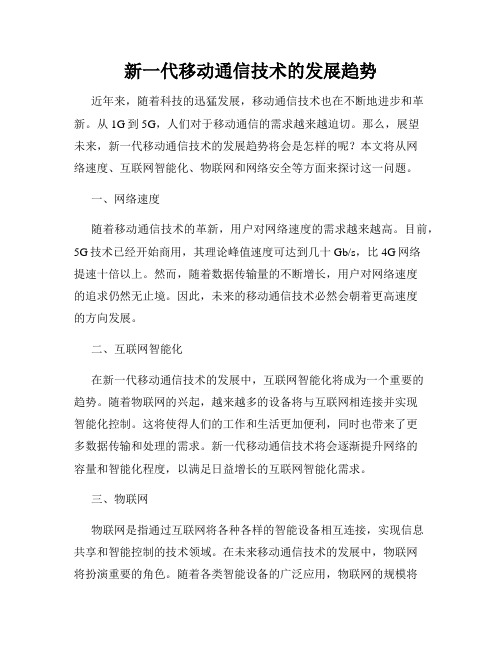
新一代移动通信技术的发展趋势近年来,随着科技的迅猛发展,移动通信技术也在不断地进步和革新。
从1G到5G,人们对于移动通信的需求越来越迫切。
那么,展望未来,新一代移动通信技术的发展趋势将会是怎样的呢?本文将从网络速度、互联网智能化、物联网和网络安全等方面来探讨这一问题。
一、网络速度随着移动通信技术的革新,用户对网络速度的需求越来越高。
目前,5G技术已经开始商用,其理论峰值速度可达到几十Gb/s,比4G网络提速十倍以上。
然而,随着数据传输量的不断增长,用户对网络速度的追求仍然无止境。
因此,未来的移动通信技术必然会朝着更高速度的方向发展。
二、互联网智能化在新一代移动通信技术的发展中,互联网智能化将成为一个重要的趋势。
随着物联网的兴起,越来越多的设备将与互联网相连接并实现智能化控制。
这将使得人们的工作和生活更加便利,同时也带来了更多数据传输和处理的需求。
新一代移动通信技术将会逐渐提升网络的容量和智能化程度,以满足日益增长的互联网智能化需求。
三、物联网物联网是指通过互联网将各种各样的智能设备相互连接,实现信息共享和智能控制的技术领域。
在未来移动通信技术的发展中,物联网将扮演重要的角色。
随着各类智能设备的广泛应用,物联网的规模将持续扩大,对于网络带宽和连接质量提出了更高的要求。
因此,新一代移动通信技术将会加强对物联网的支持,提供更快的连接速度和更稳定的信号覆盖。
四、网络安全随着移动通信技术的快速发展,网络安全问题也日益突出。
未来的新一代通信技术将会更加重视网络安全的保护,加强对用户隐私和数据安全的保护措施。
同时,随着物联网的普及,更多设备的连接也使得网络安全面临更大的挑战。
因此,新一代移动通信技术将会加强网络安全技术的研发,为用户提供更加安全可靠的通信环境。
总结起来,新一代移动通信技术的发展趋势将主要聚焦在提高网络速度、推动互联网智能化、促进物联网的发展以及加强网络安全等方面。
这些趋势不仅可以满足人们日益增长的通信需求,还能够推动社会和经济的发展。
移动通信系统技术的发展

移动通信系统技术的发展移动通信系统技术是指用于实现移动通信的一系列技术和设备。
随着科技的进步和人们对通信需求的不断增加,移动通信系统技术也得到了快速的发展和创新。
本文将从不同角度介绍移动通信系统技术的发展。
一、移动通信系统技术的起源和发展移动通信系统技术的起源可以追溯到上世纪80年代,当时的移动通信主要采用模拟信号传输。
然而,模拟信号传输存在信号质量差、抗干扰能力低等问题,无法满足日益增长的通信需求。
为了克服这些问题,人们开始研发数字通信技术,并于上世纪90年代初推出了第一代数字移动通信系统(1G)。
二、移动通信系统技术的演进和创新随着移动通信系统技术的不断发展,人们提出了更高的要求。
为了满足这些要求,移动通信系统技术经历了几代的演进和创新。
1. 第二代移动通信系统(2G)2G技术采用数字信号传输,具备了更高的通信质量和抗干扰能力。
同时,2G技术还引入了短信功能,使得人们可以通过手机发送和接收文本消息。
2. 第三代移动通信系统(3G)3G技术在2G技术的基础上进一步发展,实现了更快的数据传输速度和更广的覆盖范围。
3G技术还引入了视频通话、移动互联网等新的功能,为移动通信带来了更多的可能性。
3. 第四代移动通信系统(4G)4G技术是目前最先进的移动通信技术,具备更高的数据传输速度和更低的延迟。
4G技术还引入了更多的应用场景,如高清视频直播、移动支付等,为人们的生活和工作提供了更多便利。
4. 第五代移动通信系统(5G)5G技术是当前移动通信系统技术的热点和关注焦点。
5G技术将进一步提高数据传输速度和网络容量,实现更低的延迟和更广的覆盖范围。
5G技术还将支持更多的智能设备和物联网应用,为人们的日常生活带来更多的可能性。
三、移动通信系统技术的应用和影响移动通信系统技术的发展不仅改变了人们的通信方式,也对社会经济产生了深远影响。
1. 通信方式的改变随着移动通信系统技术的发展,人们可以通过手机随时随地进行语音通话、短信发送、视频通话等。
移动通信技术及展望

移动通信技术及展望第一点:移动通信技术的发展历程与现状自20世纪80年代以来,移动通信技术经历了从1G模拟通信到4G高速数据通信的演变,目前正在向5G和未来的6G通信技术迈进。
1G时代的模拟通信系统,如AMPS(高级移动电话服务),因其较低的通话质量和有限的可靠性,在今天看来已经显得相当原始。
2G时代引入了数字通信技术,如GSM(全球移动通信系统),显著提升了通信的稳定性和质量。
随着技术的不断进步,3G带来了数据传输的速度提升,4G则进一步推动了移动互联网的普及,支持了视频会议、高清视频流媒体和更快速度的数据服务。
目前,4G网络已经在全球范围内广泛部署,而5G技术的推出正在逐步改变通信的面貌。
5G技术通过更高的频段和更宽的带宽,实现了更快的数据传输速度,更低的延迟,以及更广泛的连接能力。
5G正被应用于智能城市、自动驾驶汽车、远程医疗和工业自动化等多个领域,其对社会的深远影响正逐步显现。
第二点:未来移动通信技术的展望面向未来,移动通信技术的发展似乎没有止境。
6G通信技术已在研究之中,尽管它还在早期阶段,但已经预期将在2030年左右投入商用。
6G将基于5G的foundations,进一步扩大频谱范围,使用更高频段的电磁波,比如太赫兹波,以实现更高的数据传输速率和更广泛的连接。
6G将致力于实现更智能、更自适应的网络,通过集成人工智能和机器学习,网络将能够自我优化,实时响应用户需求。
此外,6G有望支持更加先进的虚拟现实、增强现实以及混合现实技术,为用户带来更加沉浸式的体验。
在物联网方面,6G将使得更多的设备实现互联,推动智慧城市、智能家居和智能制造等领域的进步。
然而,随着技术的发展,移动通信也面临着一系列挑战,包括频谱资源的稀缺性、网络部署的高成本、能源消耗问题,以及日益增长的网络安全和隐私保护需求。
解决这些挑战,将需要政策制定者、行业领导者和技术开发者之间的紧密合作和精心规划。
在不断追求技术进步的同时,确保技术的普及和可持续发展也是重要的。
移动通信发展史及未来趋势
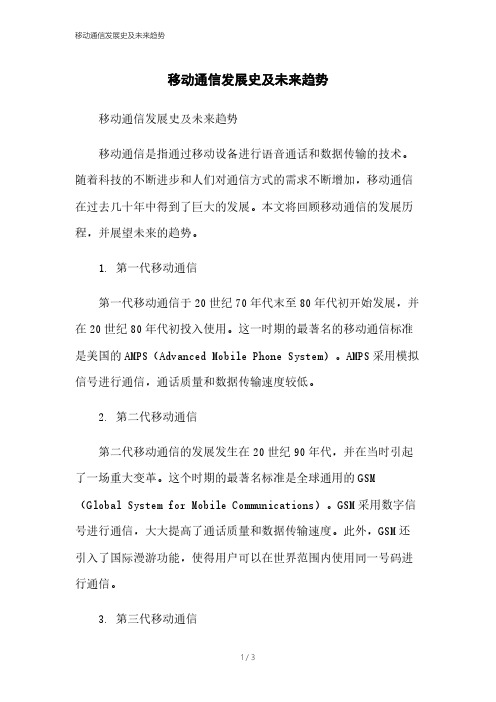
移动通信发展史及未来趋势移动通信发展史及未来趋势移动通信是指通过移动设备进行语音通话和数据传输的技术。
随着科技的不断进步和人们对通信方式的需求不断增加,移动通信在过去几十年中得到了巨大的发展。
本文将回顾移动通信的发展历程,并展望未来的趋势。
1. 第一代移动通信第一代移动通信于20世纪70年代末至80年代初开始发展,并在20世纪80年代初投入使用。
这一时期的最著名的移动通信标准是美国的AMPS(Advanced Mobile Phone System)。
AMPS采用模拟信号进行通信,通话质量和数据传输速度较低。
2. 第二代移动通信第二代移动通信的发展发生在20世纪90年代,并在当时引起了一场重大变革。
这个时期的最著名标准是全球通用的GSM (Global System for Mobile Communications)。
GSM采用数字信号进行通信,大大提高了通话质量和数据传输速度。
此外,GSM还引入了国际漫游功能,使得用户可以在世界范围内使用同一号码进行通信。
3. 第三代移动通信第三代移动通信标准(3G)在21世纪初开始发展,标志着移动通信进入了全新的时代。
3G使用了更高的频率和更先进的调制技术,提供更高的数据传输速度和更广泛的业务功能。
同时,3G还引入了视频通话和高速互联网接入等创新功能。
4. 第四代移动通信第四代移动通信标准(4G)在2010年左右开始商用,并在现代移动通信中扮演着重要角色。
4G采用了全IP网络架构和OFDMA调制技术,能够提供更高的数据传输速度和更低的延迟。
4G还支持更丰富的多媒体服务,如高清视频流媒体和在线游戏。
5. 第五代移动通信第五代移动通信标准(5G)是当前移动通信领域的热门话题。
5G的特点包括更高的数据传输速度、更低的延迟、更大的网络容量和更多的连接设备。
5G将支持复杂的应用场景,如智能城市、自动驾驶和工业物联网。
预计未来几年内,5G将逐渐在全球范围内商用化。
6. 未来趋势除了5G,移动通信领域还有其他一些未来的趋势值得关注。
- 1、下载文档前请自行甄别文档内容的完整性,平台不提供额外的编辑、内容补充、找答案等附加服务。
- 2、"仅部分预览"的文档,不可在线预览部分如存在完整性等问题,可反馈申请退款(可完整预览的文档不适用该条件!)。
- 3、如文档侵犯您的权益,请联系客服反馈,我们会尽快为您处理(人工客服工作时间:9:00-18:30)。
移动通信技术发展及展望Mobile communication technology development andprospects电子通信与物理学院专业、班级:通信14-1报告人:杜超论文结题时间:2014.1摘要:在过去的10年中,世界电信发生了巨大的变化,移动通信特别是蜂窝小区的迅速发展,使用户彻底摆脱终端设备的束缚、实现完整的个人移动性、可靠的传输手段和接续方式。
进入21世纪,移动通信将逐渐演变成社会发展和进步的必不可少的工具。
移动通信技术日新月异,先后经历了第一代、第二代移动通信技术的兴起与淘汰,完成了第三代移动通信技术的快速覆盖与普及,目前正在进行第四代移动通信技术的尝试与推广,以及第五代移动通信技术的研究与探索。
相信在越来越先进的科学技术的强有力支持下,以及未来移动数据通信与多媒体业务需求发展的需求下,第四代移动通信技术会给人们带来更加美好的未来。
关键词:移动通信;发展历程;发展趋势Abstract:I n the past ten years, great changes have taken place in the world telecom, mobile communications, especially the rapid development of the cell, the user completely get rid of the bondage of terminal equipment, to achieve a complete personal mobility, reliable transmission means and ways. Entering the 21st century, mobile communication will gradually evolve into the tools of social development and progress. Mobile communication technology, has experienced the rise of the first generation and second generation of mobile communication technology and eliminated, completed the rapid coverage and popularity of the third generation mobile communication technology, is currently in the fourth generation mobile communication technology to try and promotion, as well as the fifth generation of mobile communication technology research and exploration. Believe that there are more and more advanced under the strong support of science and technology, and the future development of mobile data communication and multimedia business requirements, under the requirements of the fourth generation mobile communication technology will bring people a better future.Key words:Mobile communication; The development course; The development trend目录摘要关键词一、第一代移动通信技术 (1)二、第二代移动通信技术 (1)三、第三代移动通信技术 (2)四、第四代移动通信技术 (3)1.简介 (3)2.核心技术 (4)3.网络结构 (7)4.4G特点 (7)5.4G标准 (9)五、未来展望——第五代移动通信技术 (16)1.发展现状 (16)2.最新研究成果 (17)六、结束语 (19)参考文献一、第一代移动通信技术第一代移动通信技术(1G)是指最初的模拟、仅限语音的蜂窝电话标准,制定于上世纪80年代。
Nordic移动电话(NMT)就是这样一种标准,应用于Nordic国家、东欧以及俄罗斯。
其它还包括美国的高级移动电话系统(AMPS),英国的总访问通信系统(TACS)以及日本的JTAGS,西德的 C-Netz,法国的Radiocom 2000和意大利的RTMI。
模拟蜂窝服务在许多地方正被逐步淘汰。
第一代移动通信主要采用的是模拟技术和频分多址(FDMA)技术。
由于受到传输带宽的限制,不能进行移动通信的长途漫游,只能是一种区域性的移动通信系统。
第一代移动通信有多种制式,我国主要采用的是TACS。
第一代移动通信有很多不足之处,如容量有限、制式太多、互不兼容、保密性差、通话质量不高、不能提供数据业务和不能提供自动漫游等。
二、第二代移动通信技术第二代移动通信系统(2G)起源于90年代初期。
欧洲电信标准协会在1996年提出了GSMPhase2+,目的在于扩展和改进GSMPhase1及Phase2中原定的业务和性能。
它主要包括CMAEL(客户化应用移动网络增强逻辑),S0(支持最佳路由)、立即计费,GSM900/1800双频段工作等内容,也包含了与全速率完全兼容的增强型话音编解码技术,使得话音质量得到了质的改进;半速率编解码器可使GSM系统的容量提近一倍。
在GSMPhase2+阶段中,采用更密集的频率复用、多复用、多重复用结构技术,引入智能天线技术、双频段等技术,有效地克服了随着业务量剧增所引发的GSM系统容量不足的缺陷;自适应语音编码(AMR)技术的应用,极大提高了系统通话质量;GPRs/EDGE 技术的引入,使GSM与计算机通信/Internet有机相结合,数据传送速率可达115/384kbit/s,从而使GSM功能得到不断增强,初步具备了支持多媒体业务的能力。
尽管2G技术在发展中不断得到完善,但随着用户规模和网络规模的不断扩大,频率资源己接近枯竭,语音质量不能达到用户满意的标准,数据通信速率太低,无法在真正意义上满足移动多媒体业务的需求。
三、第三代移动通信技术第三代移动通信技术(3G),是指支持高速数据传输的蜂窝移动通讯技术。
3G服务能够同时传送声音及数据信息,速率一般在几百kbps 以上。
3G是指将无线通信与国际互联网等多媒体通信结合的新一代移动通信系统,目前3G存在3种标准:CDMA2000、WCDMA、TD-SCDMA。
3G下行速度峰值理论可达3.6Mbit/s(一说2.8Mbit/s),上行速度峰值也可达384kbit/s。
不可能像网上说的每秒2G,当然,下载一部电影也不可能瞬间完成。
中国国内支持国际电联确定三个无线接口标准,分别是中国电信的CDMA2000,中国联通的WCDMA,中国移动的TD-SCDMA,GSM设备采用的是时分多址,而CDMA使用码分扩频技术,先进功率和话音激活至少可提供大于3倍GSM网络容量,业界将CDMA技术作为3G的主流技术,国际电联确定三个无线接口标准,分别是美国CDMA2000,欧洲WCDMA,中国TD-SCDMA。
原中国联通的CDMA 卖给中国电信,中国电信已经将CDMA升级到3G网络,3G主要特征是可提供移动宽带多媒体业务。
已有538个WCDMA运营商在246个国家和地区开通了WCDMA 网络,3G商用市场份额超过80%,而WCDMA向下兼容的GSM网络已覆盖184个国家,遍布全球,WCDMA用户数已超过6亿。
四、第四代移动通信技术1、简介第四代移动通信技术(4G)该技术包括TD-LTE和FDD-LTE两种制式(严格意义上来讲,LTE只是3.9G,尽管被宣传为4G无线标准,但它其实并未被3GPP认可为国际电信联盟所描述的下一代无线通讯标准IMT-Advanced,因此在严格意义上其还未达到4G的标准。
只有升级版的LTE Advanced才满足国际电信联盟对4G的要求)。
4G是集3G与WLAN于一体,并能够快速传输数据、高质量、音频、视频和图像等。
4G能够以100Mbps以上的速度下载,比目前的家用宽带ADSL (4兆)快25倍,并能够满足几乎所有用户对于无线服务的要求。
此外,4G可以在DSL和有线电视调制解调器没有覆盖的地方部署,然后再扩展到整个地区。
很明显,4G有着不可比拟的优越性。
2、核心技术2.1接入方式和多址方案(正交频分复用)是一种无线环境下的高速传输技术,其主要思想就是在频域内将给定信道分成许多正交子信道,在每个子信道上使用一个子载波进行调制,各子载波并行传输。
尽管总的信道是非平坦的,即具有频率选择性,但是每个子信道是相对平坦的,在每个子信道上进行的是窄带传输,信号带宽小于信道的相应带宽。
OFDM技术的优点是可以消除或减小信号波形间的干扰,对多径衰落和多普勒频移不敏感,提高了频谱利用率,可实现低成本的单波段接收机。
OFDM 的主要缺点是功率效率不高。
2.2调制与编码技术4G移动通信系统采用新的调制技术,如多载波正交频分复用调制技术以及单载波自适应均衡技术等调制方式,以保证频谱利用率和延长用户终端电池的寿命。
4G移动通信系统采用更高级的信道编码方案(如Turbo码、级连码和LDPC等)、自动重发请求(ARQ)技术和分集接收技术等,从而在低Eb/N0条件下保证系统足够的性能。
2.3高性能的接收机4G移动通信系统对接收机提出了很高的要求。
Shannon定理给出了在带宽为BW的信道中实现容量为C的可靠传输所需要的最小SNR。
按照Shannon定理,可以计算出,对于3G系统如果信道带宽为5MHz,数据速率为2Mb/s,所需的SNR为l.2dB;而对于4G系统,要在5MHz的带宽上传输20Mb/s的数据,则所需要的SNR为12dB。
可见对于4G系统,由于速率很高,对接收机的性能要求也要高得多。
2.4智能天线技术智能天线具有抑制信号干扰、自动跟踪以及数字波束调节等智能功能,被认为是未来移动通信的关键技术。
智能天线应用数字信号处理技术,产生空间定向波束,使天线主波束对准用户信号到达方向,旁瓣或零陷对准干扰信号到达方向,达到充分利用移动用户信号并消除或抑制干扰信号的目的。
这种技术既能改善信号质量又能增加传输容量。
2.5MIMO技术(多输入多输出)技术是指利用多发射、多接收天线进行空间分集的技术,它采用的是分立式多天线,能够有效的将通信链路分解成为许多并行的子信道,从而大大提高容量。
